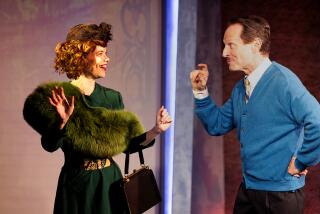‘Nelken,’ Winking at the Audience
- Share via
Midway through Pina Bausch’s “Nelken” (Carnations) comes a passage of contemptuous ballet: classical steps angrily executed, first by Bernd Marszan and then by the more subtly mocking Dominique Mercy. Marszan cuts off his virtuoso display by telling us that if we want more we can do it ourselves, while Mercy keeps asking what we want to see--how many entrechats will satisfy us?
This is Ground Zero for Bausch’s parody of audience manipulation techniques in a complex but often sweetly whimsical and ultimately triumphant 1982 theater piece that received its West Coast premiere at UCLA on Tuesday, performed by Bausch’s Tanztheater Wuppertal.
Within its two hours (no intermission), we will also see a line of dancers numbly applaud while four stuntmen pummel one another. We’ll watch Aida Vainieri using sexy leers and ricky-tick shoulder shrugs to turn potato peeling into performance art; men plunging their faces into piles of newly chopped onions in order to look suitably stricken; and Jan Minarik wishing everyone a Merry Christmas flanked by guard dogs and anything-but-merry security personnel.
And let’s not forget Julie Anne Stanzak as a topless accordion player who never plays a note but launches a silly little four seasons line-dance by the full company that may well represent the ultimate statement of empty sophistication and painted smiles.
At the end, when Lutz Forster launches an interactive hug-the-audience exercise, and members of the company gather in a nostalgic ballet-class grouping to offer ever-so-deeply-personal revelations of how and why they became dancers, we may suspect we’ve been had every which way: seduced and abandoned, conned and laughed at, the very reasons why we’re in Royce Hall watching Pina Bausch held up to ridicule.
Not to worry. Audience manipulation may be on Bausch’s mind throughout “Nelken,” but loss of innocence ultimately looms larger. And here Bausch proves endlessly compassionate, cherishing the freedoms of childhood and mourning their inevitable subjugation to parental and then societal discipline.
Her work takes its title from the thousands of pink and white carnations standing in neat little rows on Peter Pabst’s set: flowers fated to be trampled underfoot just as the playful, childlike dancers in their pastel satiny dresses will be crushed by continual spanking, force-feeding and rituals of regimentation.
*
Minarik embodies unyielding control in this sad coming-of-age parable, initially tracking the others to monitor their heartbeats, then becoming savagely repressive when mass handstands and other movement games erupt all over the stage. Indeed, he turns out to be an oppressor for all seasons, in one moment punishing Eddie Martinez like an angry father and in the next morphing into a Kafkaesque government agent who demands to see Martinez’s passport.
As his power grows, Minarik forces extended acts of degradation from a number of company members--with Mercy getting the worst of it--and Bausch gives him the very last word in “Nelken” as a demented drag diva. Does it warm our cockles to hear how and why he became a dancer? Not exactly, but that’s how “Nelken” ends: under his thumb.
But it’s the enigmatic Forster who pulls together the themes of audience manipulation and societal conditioning, suggesting that what we’re desperate to find in the theater is exactly what was drilled out of us in childhood. Sometimes he functions as a sub-Minarik boss man keeping the other dancers in line, and he is also given a petulant outburst that nails the frustration that supposedly exists on both sides of the “Nelken” footlights when all the obvious strategies for pleasing the audience run dry: “This is a complete waste of time! You’re yawning already and I’ve got sore feet.”
However, Forster also becomes Bausch’s emblem for what you might call the indomitable creative spirit, whether dancing on a tabletop--even with Minarik ordering Martinez to take the table away--or reaching out to the near-catatonic Mercy and helping him cope through both the therapy of expressive movement and his endearing advice to “generate the spirit of good humor.”
It’s that spirit that makes “Nelken” so surprisingly, disarmingly optimistic as an artistic testament: a statement about how our lives are sustained and redeemed by fantasy--even cynically manipulated fantasy.
As the torchbearer for the European dance theater movement--a genre with roots going back to the birth of modern dance--Bausch has become identified with dark visions of brutality and the hopeless search for love. She has also served as the icon of a movement-theater style that minimizes conventional dancing in favor of an eclectic array of disciplines governed by the definition of character and the expansion of gesture into whole-body expression.
Beyond its other achievements, “Nelken” provides a compact, unexpectedly celebratory point of entry to that vision and that style as well as a spectacular vehicle for a 27-member company honed to dance and to act, to tell the truth and to lie, with equal brilliance.
* The Pina Bausch Tanztheater Wuppertal performs “Nelken” tonight through Saturday at 8 p.m., and Sunday at 4 p.m., in Royce Hall on the UCLA campus in Westwood. $16-$60. (310) 825-2101.
More to Read
The biggest entertainment stories
Get our big stories about Hollywood, film, television, music, arts, culture and more right in your inbox as soon as they publish.
You may occasionally receive promotional content from the Los Angeles Times.










